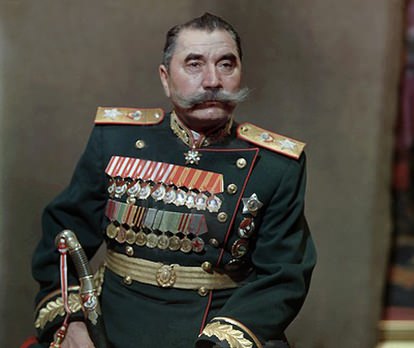(1883- 1973)
Cavalry officer, marshal of the Soviet Union, deputy commissar of defense, and commander in chief of the Soviet armies on the Southwestern Front during World War II. Semen Mikhailovich Budenny was born in Koziurin, in the Cossack district of the Don Oblast, on April 25, 1883. The son of non-Cossack peasants, he was conscripted into the Russian army in 1903 as a private, having previously taught himself to read. He fought in the Russo- Japanese War in a cavalry regiment, eventually becoming a noncommissioned officer.
At the beginning of World War I, Budenny was still in the army; he rose to sergeant major by 1917. He actively participated in the October (Bolshevik) Revolution and in the Russian Civil War, at one point winning a guerilla engagement against the vastly superior forces led by Anton Denikin that made him a legend of Soviet folk tales and songs.
During the Russian Civil War, Budenny raised a guerilla unit, the nucleus of the Red Army cavalry, to fight White Army forces on the Don. His unit grew to 100 men, and in second half of 1918 he was instrumental in winning the Battle for Tsaritsyn under the leadership of Josef Stalin, then local chairman of the military committee. Budenny was promoted quickly during 1919, commanding a cavalry division in January, a cavalry corps in June, and the First Cavalry Army in November. That same year he became a member of the Bolshevik (Communist) Party.
He served during the war with Poland in 1920, relieving Kiev but being defeated by General Maxime Weygand at Warsaw. Budenny then fought in the Crimea, virtually wiping out General Pyotr Wrangel’s army. Under the sponsorship of Stalin, now chairman of the Communist Party, his career continued to flourish. In 1924 he became a member of the Executive Committee of the Soviet Union. From 1928 to 1932 he attended the Moscow Military Academy, graduating with honors, and in 1935 became a marshal.
In 1937 Budenny was appointed commander of the Moscow Military District, and in 1939 he became a member of the Central Committee of the Communist Party. At the outbreak of World War II, he commanded an army in the war against Finland. In August 1940, he was appointed Deputy Commissar of Defense. After the German invasion he was appointed commander- in-chief of the Southwest Front (army group), comprising 69 divisions, in which capacity he served from July to November 1941. He managed to escape the German encirclement at Kiev; however, as a result of this disastrous defeat, he was relieved of his command by Marshal Semen Timoshenko.
Budenny was then placed in charge of the Reserve Front (September–October 1941), then made Commander-in-Chief of the troops in the North Caucasus Direction (April–May, 1942), Commander of the North Caucasus Front (May–August, 1942) and Cavalry Inspector of the Red Army (since 1943), as well as various honorific posts. Despite being scapegoated by Stalin for some of the Soviet Union’s most catastrophic World War II defeats (although acting on Stalin’s specific orders), Stalin had need for popular Civil War heroes: he continued to enjoy Stalin’s patronage and suffered no real punishment. After the war he was allowed to retire as a Hero of the Soviet Union and he died of a brain hemorrhage in 1973.
Budenny was a crack shot and an avid horseman. He remained a member of the Central Committee until 1961.
Budenny wrote a five-volume memoir, in which he described the stormy years of civil war as well as the everyday life of the First Cavalry Army. He was frequently commemorated for his bravery in many popular Soviet military songs, including The Red Cavalry song (Konarmieyskaya) and The Budyonny March. Budenovka, a part of Soviet military uniform, is named after Semyon Budenny . He was also frequently named in the cavalry-oriented works of Isaac Babel. Babel had originally begun covering Budenny as a writer for a Soviet newspaper during the Polish–Soviet War.
Budenny, who was a renowned horse breeder, also created a new horse breed that is still kept in large numbers in Russia: the Budenny horse, which is famous for its high performance in sports and endurance.
Semyon Budenny was also a good amateur bayan player, a few instrumental vinyl records were issued in USSR featuring his duo with his friend – cossack bayanist Grigory Zaytsev, titled as “Duo of bayanists”
Further Reading Budenny, Semyon. The Path of Valor. Moscow: Progress, 1972. Montefiore, Simon. Stalin: Court of the Red Tsar. New York: Vintage, 2005. Shukman, Harold. Stalin’s Generals. New York: Grove Press, 1993.
